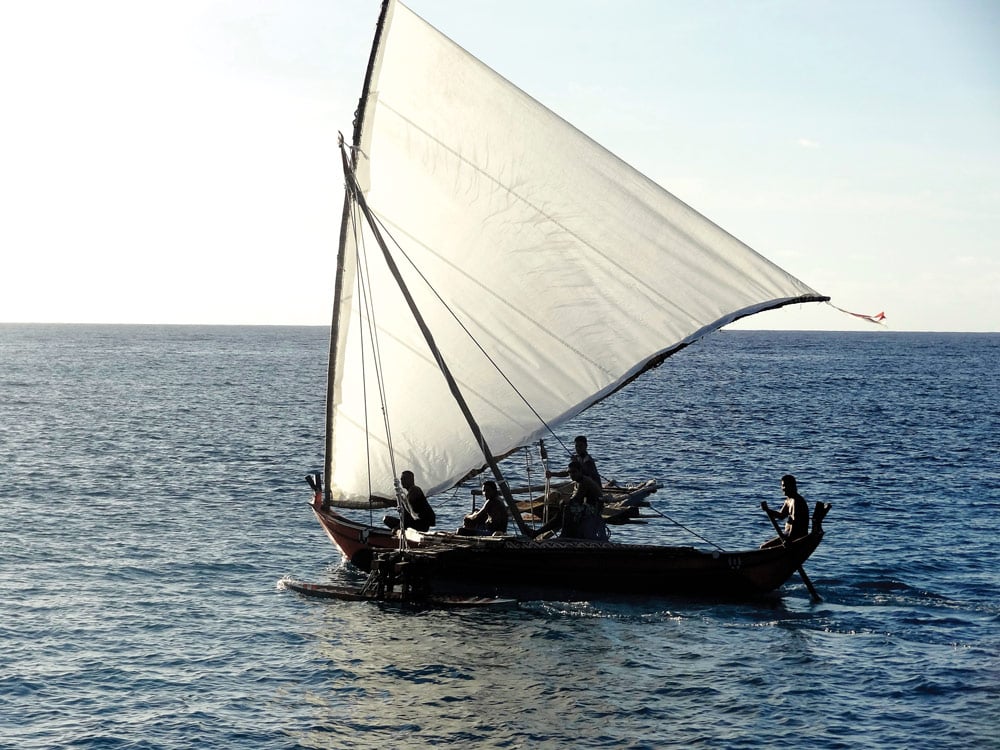
It had been a slog all the way from Panama to Micronesia’s islands. The trades of 2017 failed. Giant thunderstorms, calms, variable headwinds, contrary currents and sloppy seas prevailed all the way to the Marquesas and beyond. In 4,000 miles to Kosrae, the Caroline Islands, we averaged 4 knots. As once again our Creekmore 36, Koukouri, continued to spin in circles on the windless ocean, we abandoned the idea of reaching Kapingamarangi Atoll and decided to head farther north in search of steadier airs. Ifalik Atoll, small at 3 miles across, became the new objective.
Three days later, cottony clouds began to float overhead, and the wind arrived. On the horizon ahead I spotted a dozen sails, their shape obviously not of yachts. The pass into Ifalik, though narrow, was deep and clear of hazards. After a visit with the chief of the village to pay a fee for the anchorage and landing privileges, we roamed the island — a scene from the dreams of South Pacific.
At the water’s edge rested outrigger proas: 15 large ones and more than 10 smaller. The friendly men described building them out of breadfruit-tree timber and sewing every hull piece with monofilament, iron fasteners being totally absent. Coconut husk and breadfruit sap make the caulking goop, and ropes are often twisted from coconut fibers. Sometimes a visiting yacht will pass on some used but still highly valued synthetic lines.
While changing tacks, the crew of a proa swings the sail around completely since the stern becomes the new bow.
“Oh, certainly you can go fishing with us. Come at 4.” They meant in the morning. It was still pitch black when I found them in the Canoe House, a sort of men’s club, making lures out of coconut palm fronds. Afloat soon after, on the way out under an enormous combination of spars and the sail, a thunderstorm hit. Flying spray and rain lashing at 20 to 25 knots made us shiver with cold. Shadows of other boats rushed close by, occasionally showing the feeble glow of a flashlight. They placed me out of the way on the outrigger as the boat tacked toward the pass.
While changing tacks, the crew of a proa swings the sail around completely since the stern becomes the new bow — a challenging operation that kept all four guys busy in the dark and wind. The man at the sheet is essential to spill the wind in gusts. A closehauled or beam-reaching proa tracks straight as if on rails at 6 or so knots all by itself. Off the wind, a big steering oar is shipped; the helmsman perched on the boat’s end holds the oar down with his foot and mans a short tiller to control its angle.
Out on the open water, the men spotted birds feeding where I could only see empty sky. With four trolling lines, they caught three tuna and headed back for the pass. In the narrow cut, three proas side by side, the men chatting, laughing, so fully at ease with the boats, complex sails and the sea, I felt strongly moved. This little voyage showed me a way of life that is many generations old, and to see how little these men needed to lead happy lives made an impression on me. Talk about a small footprint on the earth!
As I rowed back to my fiberglass boat, my Dacron sails, my stainless-steel rigging, my diesel engine, my GPS, my propane stove, my pressure shower and my fridge, I thought of some way to help the village. First to go was a somewhat used 100 feet of ¾-inch braided line. They badly need sailcloth, but I didn’t have any to give. At times, visiting yachts unload their tired sails to the village to serve for a few more years.
Fishing at one atoll, Nukuoro, became so poor that several men had to abandon families and their island and signed on to the very vessels that kill their traditions.
There is not a single sewing machine in Ifalik, so all sail conversion is done by hand, and they need needles and thread. I learned that their government in Yap has a small fund for traditional proas. This oceanic country, Federated States of Micronesia, wants to maintain its maritime traditions and avoid dependence on fiberglass boats and outboard engines that demand fuel. I appeal to anyone who can supply sailcloth at wholesale prices to reach out to me. A large proa carries a bit over 300 square feet of sail.
The resources in the western Pacific Ocean near Micronesia are under threat. Monstrous purse seiners from Japan, China and Korea, some with permits, others poaching, large enough to stay at sea through typhoons, fish year-round and often refuel at sea. They anchor steel platforms called fish aggregating devices in hundreds of fathoms. Fish commonly gather underneath, and a lucky ship can snatch a hundred tons of tuna in one haul.
Such fishery affects the population of the atolls. The seiners work their crews hard for little money, and routinely need more bodies. Fishing at one atoll, Nukuoro, became so poor that several men had to abandon families and their island and signed on to the very vessels that kill their traditions. It is virtually the last years to keep these oceanic cultures going — help them if you can!
For more information, contact Claude Appaldo on Koukouri in the Philippines.








